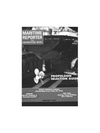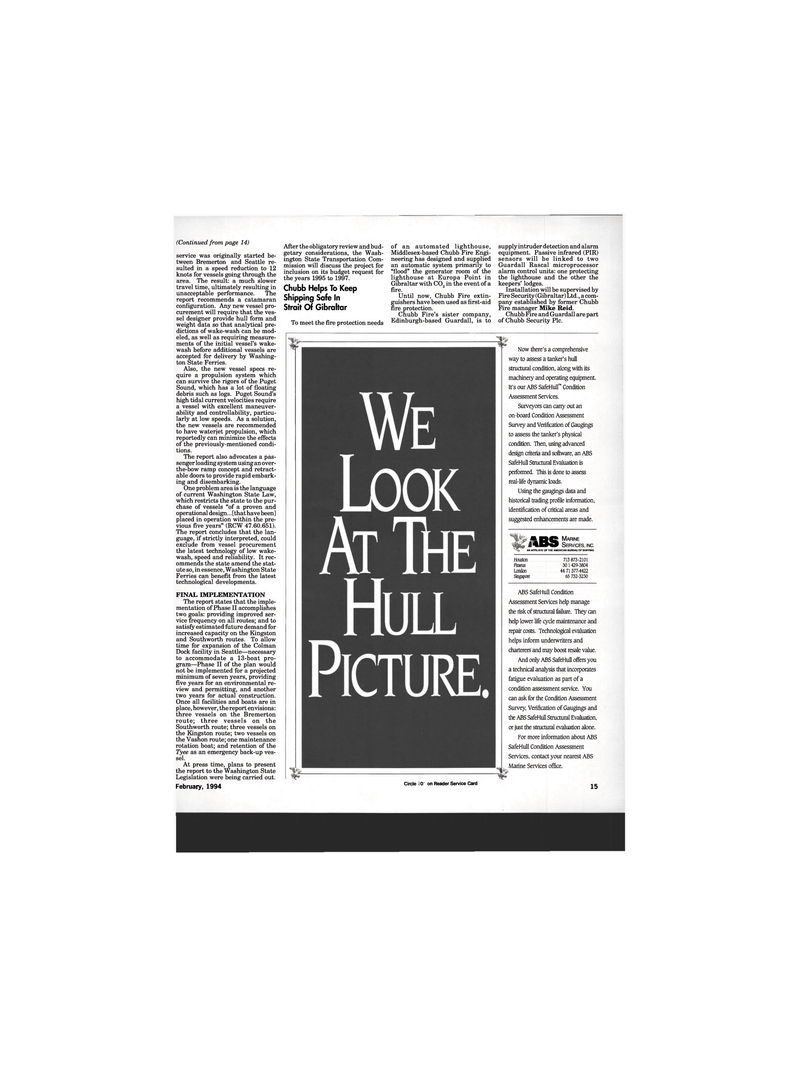
Page 9: of Maritime Reporter Magazine (February 1994)
Read this page in Pdf, Flash or Html5 edition of February 1994 Maritime Reporter Magazine
(Continued from page 14) service was originally started be- tween Bremerton and Seattle re- sulted in a speed reduction to 12 knots for vessels going through the area. The result: a much slower travel time, ultimately resulting in unacceptable performance. The report recommends a catamaran configuration. Any new vessel pro- curement will require that the ves- sel designer provide hull form and weight data so that analytical pre- dictions of wake-wash can be mod- eled, as well as requiring measure- ments of the initial vessel's wake- wash before additional vessels are accepted for delivery by Washing- ton State Ferries.
Also, the new vessel specs re- quire a propulsion system which can survive the rigors of the Puget
Sound, which has a lot of floating debris such as logs. Puget Sound's high tidal current velocities require a vessel with excellent maneuver- ability and controllability, particu- larly at low speeds. As a solution, the new vessels are recommended to have waterjet propulsion, which reportedly can minimize the effects of the previously-mentioned condi- tions.
The report also advocates a pas- senger loading system using an over- the-bow ramp concept and retract- able doors to provide rapid embark- ing and disembarking.
One problem area is the language of current Washington State Law, which restricts the state to the pur- chase of vessels "of a proven and operational design... [that have been] placed in operation within the pre- vious five years" (RCW 47.60.651).
The report concludes that the lan- guage, if strictly interpreted, could exclude from vessel procurement the latest technology of low wake- wash, speed and reliability. It rec- ommends the state amend the stat- ute so, in essence, Washington State
Ferries can benefit from the latest technological developments.
FINAL IMPLEMENTATION
The report states that the imple- mentation of Phase II accomplishes two goals: providing improved ser- vice frequency on all routes; and to satisfy estimated future demand for increased capacity on the Kingston and Southworth routes. To allow time for expansion of the Colman
Dock facility in Seattle—necessary to accommodate a 13-boat pro- gram—Phase II of the plan would not be implemented for a projected minimum of seven years, providing five years for an environmental re- view and permitting, and another two years for actual construction.
Once all facilities and boats are in place, however, the report envisions: three vessels on the Bremerton route; three vessels on the
Southworth route; three vessels on the Kingston route; two vessels on the Vashon route; one maintenance rotation boat; and retention of the
Tyee as an emergency back-up ves- sel.
At press time, plans to present the report to the Washington State
Legislation were being carried out.
February, 1994
After the obligatory review and bud- getary considerations, the Wash- ington State Transportation Com- mission will discuss the project for inclusion on its budget request for the years 1995 to 1997.
Chubb Helps To Keep
Shipping Safe In
Strait Of Gibraltar
To meet the fire protection needs of an automated lighthouse,
Middlesex-based Chubb Fire Engi- neering has designed and supplied an automatic system primarily to "flood" the generator room of the lighthouse at Europa Point in
Gibraltar with C02 in the event of a fire.
Until now, Chubb Fire extin- guishers have been used as first-aid fire protection.
Chubb Fire's sister company,
Edinburgh-based Guardall, is to supply intruder detection and alarm equipment. Passive infrared (PIR) sensors will be linked to two
Guardall Rascal microprocessor alarm control units: one protecting the lighthouse and the other the keepers' lodges.
Installation will be supervised by
Fire Security (Gibraltar) Ltd., a com- pany established by former Chubb
Fire manager Mike Reid.
Chubb Fire and Guardall are part of Chubb Security Pic.
Circle 150 on Reader Service Card
Now there's a comprehensive way to assess a tanker's hull structural condition, along with its machinery and operating equipment.
It's our ABS SafeHull™ Condition
Assessment Services.
Surveyors can cany out an on-board Condition Assessment
Survey and Verification of Gaugings to assess the tanker's physical condition. Then, using advanced design criteria and software, an ABS
SafeHull Structural Evaluation is performed. This is done to assess real-life dynamic loads.
Using the gaugings data and historical trading profile information, identification of critical areas and suggested enhancements are made.
M pQ MARINE 1D9 SERVICES, INC.
AN AFFILIATE OF THE AMERICAN BUREAU OF SHIPPING
Houston 713 873-2101
Piraeus 30 1 429-3804
London 44 71 377-4422
Singapore 65 732-3230
ABS SafeHull Condition
Assessment Services help manage the risk of structural failure. They can help lower life cycle maintenance and repair costs. Technological evaluation helps inform underwriters and charterers and may boost resale value.
And only ABS SafeHull offers you a technical analysis that incorporates fatigue evaluation as part of a condition assessment service. You can ask for the Condition Assessment
Survey, Verification of Gaugings and the ABS SafeHull Structural Evaluation, or just the structural evaluation alone.
For more information about ABS
SafeHull Condition Assessment
Services, contact your nearest ABS
Marine Services office. 15

 8
8

 10
10
